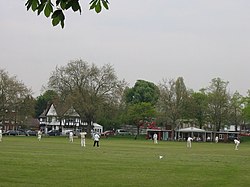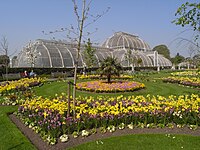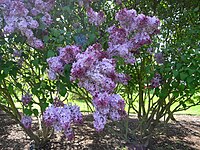Kew
| Kew | |
| Surrey | |
|---|---|
 Cricket on Kew Green | |
| Location | |
| Grid reference: | TQ195775 |
| Location: | 51°29’1"N, 0°16’41"W |
| Data | |
| Post town: | Richmond |
| Postcode: | TW9 |
| Dialling code: | 020 |
| Local Government | |
| Council: | Richmond upon Thames |
| Parliamentary constituency: |
Richmond Park |
Kew is a prosperous town in urban Surrey, which is best known for being the location of the Royal Botanic Gardens, known as Kew Gardens and now a World Heritage Site. Other points of interest include Kew Palace and The National Archives (previously known as the Public Record Office).
"Kew Village" refers to the parades of shops adjoining Kew Gardens station. It contains a small supermarket, a wholefood store, several independent retailers, restaurants (including the well-reviewed The Glasshouse) and cafes. There are also major high street retailers at the nearby Kew Retail Park (originally known as Richmond Retail Park).
Name of the town
The name Kew is a combination of two words: the Old French kai (landing place; 'quay' derives from this) and Old English hoh (spur of land). The land spur is the bend in the Thames. The name was recorded in 1327 as Cayho.[1]
Parish churches

@ St Anne.
The parish church is St Luke's Church in The Avenue.
In adjoining North Sheen, the parish church of St Philip and All Saints Church is the first barn church to be consecrated in England.[2] It is now in a combined parish with St Luke's.
History
King Henry V developed a Carthusian monastery to the south west of where Kew Observatory now stands.[3] Successive Tudor, Stuart and Georgian monarchs maintained links with Kew. One of Henry VII's closest friends, Henry Norris, lived at Kew Farm,[3] which was later owned by Elizabeth I's favourite, Robert Dudley, Earl of Leicester.[4] In Elizabeth's reign, and under the Stuarts, houses were developed along Kew Green.[5] West Hall, which survives in West Hall Road, dates from at least the 14th century and the present house was built at the end of the 17th century.[6] Queen Anne subscribed to the building of the parish church on Kew Green, which was dedicated to St Anne in 1714, three months before the queen's death.[7]
Today, Kew is a popular residential area because of its transport links and proximity to Kew Gardens. Most of Kew developed in the late 19th century, following the arrival of the District Line of the London Underground, and is characterised by large detached or semi-detached houses. Further development took place in the 1920s and 1930s when new houses were built on the market gardens of North Sheen and in the first decade of the 21st century when flats and houses were constructed at Kew Riverside on land formerly owned by Thames Water.
Kew Gardens

The Royal Botanic Gardens at Kew were well described by Arthur Mee as "the wonder gardens of the Empire".[8] To Kew were brought plants from across the Empire and the world for cultivation and study, work which continues today.
While the serious work of the botanist continues, Kew Gardens provide a delight to the visitor, who may wander though open gardens with plants and trees from across the world and into vast greenhouses filled with tropical plants; the Palm House in particular reaches high up to accommodate the great palm trees planted there in the nineteenth century and which are still growing, now filling its full height.
Quotes
I am His Highness' dog at Kew;
Pray tell me, sir, whose dog are you?
- Epigram, engraved on the Collar of a Dog which I gave to his Royal Highness (Frederick, Prince of Wales) — Alexander Pope, 1688-1744

Trams and dusty trees.
Highbury bore me. Richmond and Kew
Undid me.
- The Waste Land, 1922 (T.S.Eliot), 1888-1965
Go down to Kew in lilac-time, in lilac-time, in lilac-time;
Go down to Kew in lilac-time (it isn't far from London!)
And you shall wander hand in hand with love in summer's wonderland;
Go down to Kew in lilac-time (it isn't far from London!)
- The Barrel-Organ, Alfred Noyes, 1880-1958
Parks and open spaces
- Kew Green includes an old horse pond and is used for cricket matches in the summer.[9]
- Kew Pond, northwest of Kew Green, has a reed bed habitat and a resident population of water birds.[10]
- North Sheen Recreation Ground, in Dancer Road (known locally as "The Rec"), was originally part of an orchard belonging to the Popham Estate, owned by the Leyborne Pophams whose family seat was at Littlecote House, Wiltshire. Opened in June 1909 and extended in 1923, it now contains football pitches, a running track, a children's paddling pool, two extensive playgrounds, a large dog-free grassed area and a pavilion set amongst trees and shrubs.[11]
- Pensford Field,[12]previously playing fields of the former Gainsborough School, is now a nature reserve and also the home of Pensford Tennis Club.
- St Luke's Open Space was derived from a former Victorian school, and is now a quiet sitting area with toddlers' play equipment.[13]
- Westerley Ware Recreation Ground, a small garden and recreation ground at the foot of Kew Bridge. It has a memorial garden bordered by hedges, a grass area, three hard tennis courts and a children's playground. Originally created as a memorial garden to the fallen in the First World War, the name refers to the practice of netting weird or "wares" to catch fish.[14]

References
- ↑ Room, Adrian: Dictionary of Place-Names in the British Isles, Bloomsbury, 1988
- ↑ Blomfield, David. The Story of Kew, second edition, p36, Leyborne Publications, 1996
- ↑ 3.0 3.1 Blomfield, David: Kew Past, p5, Phillimore, 1994
- ↑ Blomfield, David: Kew Past, p12, Phillimore, 1994
- ↑ Blomfield, David: Kew Past, p16, Phillimore, 1994
- ↑ Blomfield, David: Kew Past, p18, Phillimore, 1994
- ↑ Blomfield, David: Kew Past, p23, Phillimore, 1994
- ↑ Arthur Mee, The King's England – Surrey
- ↑ "Kew Green". London Borough of Richmond Upon Thames. 24 November 2010. http://www.richmond.gov.uk/home/leisure_and_culture/parks_and_open_spaces/park_details.htm?parkId=194. Retrieved 20 June 2011.
- ↑ "Kew Pond". London Borough of Richmond Upon Thames. 24 November 2010. http://www.richmond.gov.uk/home/leisure_and_culture/parks_and_open_spaces/park_details.htm?parkId=195. Retrieved 20 June 2011.
- ↑ "North Sheen Recreation Ground". London Borough of Richmond Upon Thames. 24 November 2010. http://www.richmond.gov.uk/home/leisure_and_culture/parks_and_open_spaces/park_details.htm?parkId=215. Retrieved 29 May 2011.
- ↑ "Pensford Field". Pensford Field Environmental Trust Ltd website. http://www.pensfordfield.co.uk/. Retrieved 20 June 2011.
- ↑ "St Luke's Open Space". London Borough of Richmond Upon Thames. 24 November 2010. http://www.richmond.gov.uk/home/leisure_and_culture/parks_and_open_spaces/park_details.htm?parkId=247. Retrieved 20 June 2011.
- ↑ "Westerley Ware Recreation Ground". London Borough of Richmond Upon Thames. 24 November 2010. http://www.richmond.gov.uk/home/leisure_and_culture/parks_and_open_spaces/park_details.htm?parkId=262. Retrieved 20 June 2011.
Outside links
| ("Wikimedia Commons" has material about Kew) |
